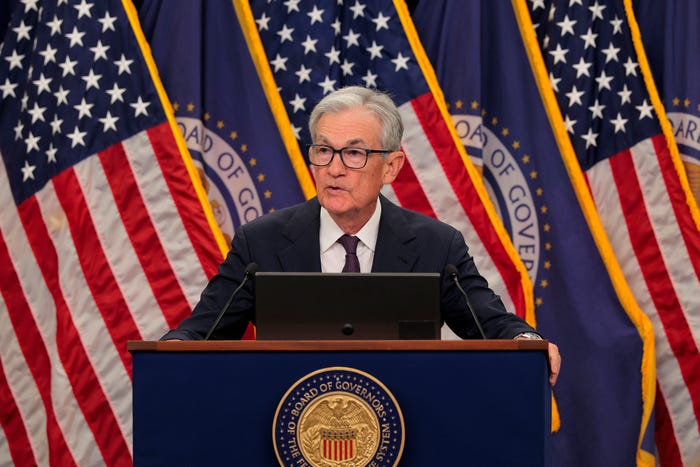Business
Fed Expected to Cut Interest Rates Amid Government Shutdown

The Federal Reserve is anticipated to announce a reduction in interest rates during its October meeting, despite the ongoing government shutdown. The Federal Open Market Committee (FOMC) is likely to implement a quarter-point cut on Wednesday, following a projected 98% probability of a rate reduction, marking the second cut of the year.
The government shutdown has disrupted the usual flow of economic data, with the Bureau of Labor Statistics unable to release the September jobs report. Additionally, inflation data, originally scheduled for October 15, has been postponed to October 24. This lack of comprehensive economic indicators presents a challenge for the Fed as it assesses the current state of the U.S. economy.
Fed Chair Jerome Powell is expected to proceed with the rate cut, influenced by a summer characterized by sluggish job growth and a slight uptick in unemployment. Inflation remains elevated at 3%, exceeding the Fed’s target of 2%. The Fed’s economic projections released last month indicated the expectation of two more rate cuts this year, which could provide relief to consumers facing higher borrowing costs for mortgages, cars, and credit cards.
In earlier comments, Powell noted the Fed’s ability to maintain a “restrictive level” of policy due to a robust labor market with strong job creation. He remarked, “I can no longer say that,” reflecting the current uncertainty surrounding employment conditions.
Challenges in Economic Data Collection
Without the latest jobs report, the Fed’s decision-making will hinge on alternative economic indicators. Inflation data, particularly the consumer price index, serves as a critical component of the Fed’s dual mandate. In September, the index rose slightly below the anticipated 3.1%, reaching 3% for the first time since January.
Financial analyst Stephen Kates from Bankrate expressed confidence that the Fed would cut rates regardless of the new inflation data. He stated, “Even if we got slightly higher inflation, the Federal Reserve had made it relatively clear that they were more comfortable with the level of inflation that we’ve had relative to now the deterioration in the labor market.”
The pre-shutdown trends in the job market further support a case for a rate cut. Job openings have decreased, and unemployment has begun to rise, indicating a mismatch between job availability and the number of Americans seeking work. Powell acknowledged last month that “the marked slowing in both the supply of and demand for workers is unusual,” which could prompt a shift toward a less restrictive policy.
Implications for Consumers
The Fed may also consider softer economic indicators as part of its decision-making process. For instance, a key marker of consumer sentiment fell in October, suggesting that Americans are increasingly feeling the pressures of high prices and limited job opportunities. A rate cut could potentially stimulate economic activity in this challenging environment.
Not all members of the Fed are in agreement regarding the extent of the necessary rate cuts. Some committee members have previously expressed dissent against Powell’s restrictive policies, with one member advocating for a 1.25% rate reduction by year-end—substantially more than the majority.
Former President Donald Trump has been vocal about his desire for further rate cuts, criticizing Powell in an October 1 post on Truth Social, stating, “I really believe that Jerome ‘Too Late’ Powell is an OBSTRUCTIONIST!”
For consumers, a sequence of rate cuts could yield tangible benefits. Mortgage rates, auto loan rates, and credit card interest rates typically fluctuate alongside the federal funds rate. Although the effects of Fed decisions may take time to filter down to consumers, consistent rate reductions could herald positive news for those with significant debt.
Kates noted that individuals with high-yield savings accounts might see a gradual decline in their interest earnings. Conversely, borrowers—including those with mortgages, credit card debt, or plans to refinance—should closely monitor these developments, as rate cuts could influence their financial decisions.
As the Fed prepares to navigate these complex dynamics amidst a government shutdown, the upcoming meeting could have lasting ramifications for the U.S. economy and its consumers.
-

 Sports2 weeks ago
Sports2 weeks agoSteve Kerr Supports Jonathan Kuminga After Ejection in Preseason Game
-

 Politics2 weeks ago
Politics2 weeks agoDallin H. Oaks Assumes Leadership of Latter-day Saints Church
-

 Business2 weeks ago
Business2 weeks agoTyler Technologies Set to Reveal Q3 2025 Earnings on October 22
-

 Science2 weeks ago
Science2 weeks agoChicago’s Viral ‘Rat Hole’ Likely Created by Squirrel, Study Reveals
-

 Lifestyle2 weeks ago
Lifestyle2 weeks agoKelsea Ballerini Launches ‘Burn the Baggage’ Candle with Ranger Station
-

 Lifestyle2 weeks ago
Lifestyle2 weeks agoDua Lipa Celebrates Passing GCSE Spanish During World Tour
-

 Entertainment2 weeks ago
Entertainment2 weeks agoZoe Saldana Advocates for James Cameron’s Avatar Documentary
-

 Health2 weeks ago
Health2 weeks agoRichard Feldman Urges Ban on Menthol in Cigarettes and Vapes
-

 Health2 weeks ago
Health2 weeks agoCommunity Unites for Seventh Annual Mental Health Awareness Walk
-

 World2 weeks ago
World2 weeks agoD’Angelo, Iconic R&B Singer, Dies at 51 After Cancer Battle
-

 Business2 weeks ago
Business2 weeks agoMLB Qualifying Offer Jumps to $22.02 Million for 2024
-

 Sports2 weeks ago
Sports2 weeks agoPatriots Dominate Picks as Raiders Fall in Season Opener







